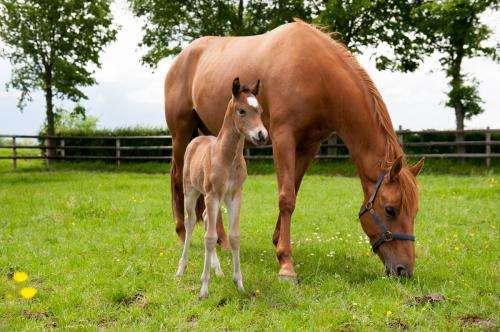Birth of four foals from genotyped, cryopreserved embryos

IFCE and INRA announced that, for the first time ever in Europe, four foals were successfully born as the result of the transfer of genotyped and cryopreserved embryos. The goal of this work is to better understand embryonic development, control livestock reproduction, and maintain breed genetic diversity. Furthermore, it is advantageous for the horse industry to be able to determine the traits of a future foal.
The INRA Val de Loire center at Nouzilly is where the technology to maintain embryo viability following genotyping and cryopreservation was honed, and then, last summer, the transfer of several embryos took place at the IFCE Haras du Pin Stud Farm, located in the French department of Orne. The partnership between the two institutions has now been cemented by the birth of the healthy foals.
What were the steps leading up to the birth of these foals?
Seven days after fertilization, embryos were collected from Welsh B ponies that are part of INRA's livestock. The embryos were genotyped: scientists sampled some of the embryos' cells to analyze their genomes. In this experiment, embryos were selected based on sex, the idea being to use sex-based selection to test the technique's feasibility. The embryos were then cryopreserved in liquid nitrogen (at -196°). Last summer, they were transferred into saddlebred mares at the Haras du Pin center. After an 11-month gestation period, the foals were born in May. They were of the expected sex: two females and two males.
This is the first time that such an event has taken place in Europe, and it is the product of more than 10 years of various types of embryonic research carried out by INRA and IFCE scientists.
What made it so difficult to apply this technique to horses?
Although embryo preservation techniques are already well developed for bovines, small ruminant species, and even humans, preserving horse embryos is a very complex process. For instance, horse embryos vary greatly in size: 7-day-old embryos range in diameter from 200 to 700 micrometers. It is very difficult to cryopreserve the largest embryos because the liquid inside them forms ice crystals when the embryos are frozen at very cold temperatures. What's more, horse embryos are surrounded by a capsule that interferes with successful cryopreservation.
What is the significance of this event, which is the first of its kind in Europe?
There are several reasons why being able to successfully cryopreserve embryos is important. For example, it allows us to maintain breed genetic diversity, particularly that of breeds with small population sizes, such as the Landais or the Poitevin Mulassier. Furthermore, the factor that currently limits the use of embryo transfer is its cost: the transfer center has to maintain a team of recipient mares that are reproductively synchronized with the donor mares. Cryopreservation means that the transfer doesn't have to take place immediately; it can wait until a recipient mare becomes available to receive the embryo. Finally, it may now be possible to directly repopulate horse herds that have experienced losses as a result of various issues, such as disease-related problems, instead of having to use the indirect technique of crossbreeding.
Why genotype the embryos?
Genotyping allows us to choose the embryos we want to use based on different criteria: sex, like in this experiment, the absence of known genetic disorders, or, perhaps in the future, other traits that are tied to behavior, such as emotivity or sociability. It is advantageous for the horse industry to be able to determine the traits of a future foal. We will next aim to simplify the process—to make this technology more accessible and user friendly for those in the horse industry.
Provided by INRA
















